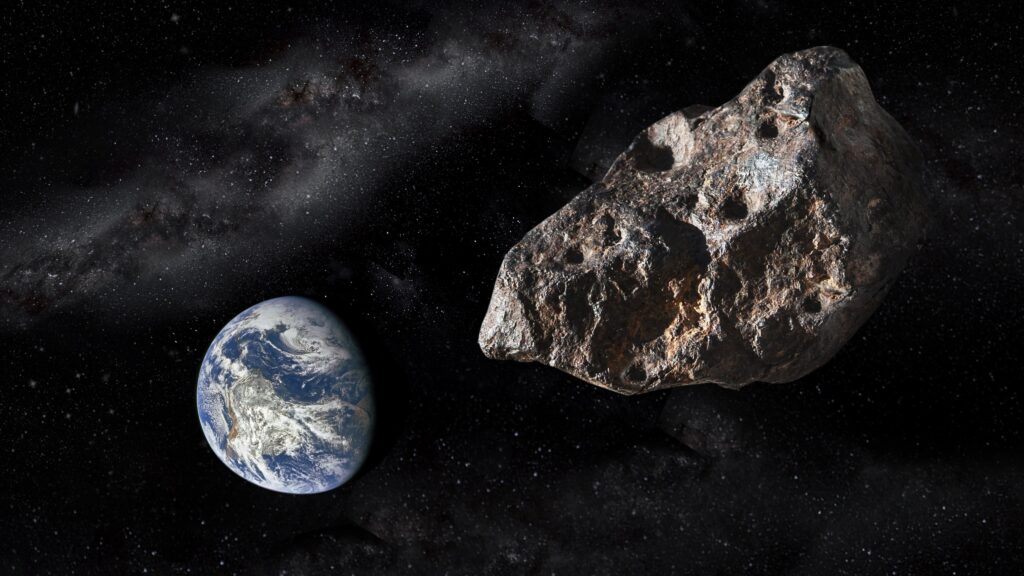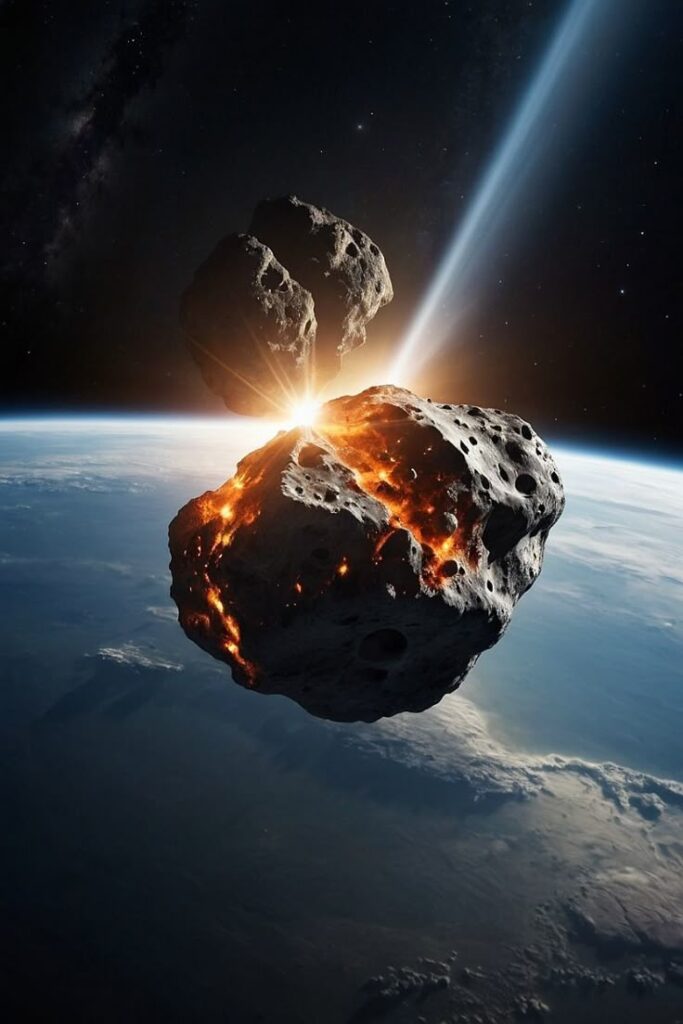A Cosmic Threat Looms Over Earth’s Closest Neighbor
In late 2024, astronomers detected an asteroid that has since captured global attention—and not in a good way. Known as 2024 YR4, this space rock, roughly 55 meters (180 feet) in diameter, has raised alarm bells across the scientific community for one startling reason: it carries a small but significant chance of slamming into the Moon in 2032.
While asteroids often whiz past Earth and its surroundings with no harm done, YR4’s trajectory is unusual enough that it has sparked intense discussions within the world’s top space agencies. For the first time in decades, scientists are openly evaluating whether the nuclear option—a last-resort defense once reserved for science fiction—might be necessary to protect both the Moon and Earth’s orbital environment.
The Discovery of 2024 YR4
The asteroid was first spotted in December 2024 by automated telescopes scanning the skies for potentially hazardous near-Earth objects (NEOs). Early calculations suggested it had a 3.1% chance of hitting Earth in 2032, a figure high enough to cause a flurry of headlines. A rock of that size would be catastrophic if it hit a populated region—capable of leveling an entire city.
But follow-up observations changed the picture. By February 2025, refined measurements reduced the direct risk to Earth to just 0.28% (about 1 in 360). That was good news for humans on the ground. However, the asteroid’s path indicated something else: a far greater chance of impacting the Moon instead.
And while the Moon might seem like a safer target than Earth, experts warn that a lunar impact could still unleash dangerous consequences for our planet.
Why a Moon Collision Matters
At first glance, one might ask: So what if an asteroid hits the Moon? After all, the lunar surface is already pockmarked with craters from countless impacts over billions of years.
But the Moon is more than just a rocky companion—it’s a stabilizer of Earth’s tilt, tides, and climate, and it plays a critical role in human space activities. A direct strike from YR4 could:
1. Create a massive spray of regolith – The Moon’s surface is coated in fine dust and rock fragments. An impact would eject enormous amounts of debris into space.
2. Increase micrometeoroid flux around Earth – Researchers estimate debris levels in Earth’s vicinity could rise by up to 1,000 times the usual background. This means satellites, space stations, and even astronauts would face a much higher risk of high-speed impacts.
3. Disrupt lunar exploration – NASA, ESA, and private companies have ambitious plans for lunar bases in the 2030s. A destabilized lunar environment could endanger these missions.
4. Psychological impact – Humanity has always looked up at the Moon as a symbol of stability. Watching it struck by a destructive asteroid would carry an enormous cultural and emotional weight.
Nuclear Defense on the Table
The idea of using nuclear weapons in space is not new. For decades, scientists have debated whether nukes could serve as the ultimate planetary defense tool against rogue asteroids.
In most scenarios, the goal isn’t to “blow up” the asteroid, which risks creating dangerous fragments. Instead, the detonation would occur near the asteroid’s surface, delivering a powerful shockwave that alters its trajectory just enough to prevent impact.
NASA, working alongside agencies such as the European Space Agency (ESA), Roscosmos, and even private firms like SpaceX, is now modeling whether such an approach could work against YR4.
Dr. Helen Ramirez, a planetary defense specialist at NASA’s Jet Propulsion Laboratory, explains:
“If the asteroid stays on its predicted course, we may only have a narrow window to act. Nuclear deflection, while controversial, might be the only option capable of delivering the energy needed to redirect it away from the Moon.”
Lessons from DART
This isn’t the first time humans have attempted to alter the path of a space rock. In 2022, NASA’s DART mission (Double Asteroid Redirection Test) successfully redirected a small asteroid called Dimorphos by crashing a spacecraft into it at high speed.
- The test proved that kinetic impactors can work. But YR4 presents different challenges:
- It’s larger than Dimorphos.
- Its potential target—the Moon—is already a massive gravitational body.
- The timescale is longer, meaning small miscalculations could add up.
As a result, scientists argue that nuclear energy may be the only tool powerful enough to guarantee a deflection in time.
Risks of a Nuclear Solution
Of course, using nuclear weapons in space is fraught with complications. International treaties like the Outer Space Treaty of 1967 strictly limit the use of nuclear devices beyond Earth.
Opponents worry that any precedent of detonating nukes in space could escalate global tensions. Others fear the technical risks: what if the detonation goes wrong, or only partially alters the asteroid’s course, sending it toward Earth instead?
Dr. Anil Kapoor, an astrophysicist at the Indian Space Research Organisation (ISRO), voiced caution:
“We must tread carefully. A failed attempt could make things worse. But doing nothing could also expose us to a dangerous surge of lunar debris. This is not just a scientific problem—it’s a geopolitical one.”
The Countdown to 2032
With the clock ticking, the next few years will be crucial. Scientists are calling for:
1. More Observations – To pin down YR4’s orbit with greater accuracy. Small changes in trajectory could dramatically alter predictions.
2. Simulation Drills – Joint exercises among international space agencies to test response protocols.
3. Technology Development – Scaling up nuclear and non-nuclear deflection methods, including kinetic impactors and gravity tractors.
4. Public Awareness – Communicating clearly with the public to avoid panic and misinformation.
Already, social media posts exaggerating the asteroid’s threat have gone viral, with some falsely claiming the Moon will be “destroyed” entirely. Scientists emphasize this is not the case—while the impact could be serious, it would not shatter the Moon.
What Happens If the Asteroid Hits?
If all defense measures fail and YR4 crashes into the Moon, the outcome would depend on the impact location and angle.
A strike on the near side (facing Earth) would be visible to the naked eye, potentially leaving a new crater large enough to see from Earth.
A strike on the far side would go unseen from the ground but could still shower debris into cislunar space.
The impact could release energy equivalent to millions of tons of TNT, shaking the lunar surface and potentially affecting future human habitats.
Importantly, the Moon’s orbit around Earth would not be significantly altered by an asteroid this size. Earth’s tides and tilt would remain stable. The main risk is the debris cloud.
Humanity’s First Lunar Defense Crisis
For centuries, humans have wondered what it would take to defend against cosmic threats. The discovery of YR4 marks the first time in modern history that such a scenario has gone beyond speculation.
Governments are now being forced to confront uncomfortable questions:
Who decides whether to launch a nuclear device into space?
What if the asteroid changes course and threatens Earth instead?
How do we balance secrecy (to prevent panic) with transparency (to build trust)?
The coming years may reshape international cooperation in space. Just as climate change has forced nations to work together, so too might the threat of asteroid impacts.
The Bigger Picture: Living in a Cosmic Shooting Gallery
YR4 is just one of thousands of near-Earth objects tracked each year. According to NASA, more than 30,000 asteroids have been cataloged that come close to Earth’s orbit. Of these, around 2,300 are classified as potentially hazardous.
Most will never hit us—but the sheer numbers highlight an unavoidable truth: Earth and its Moon are part of a cosmic shooting gallery. Sooner or later, another dangerous rock will appear on our radar.
The question is not if, but when. And whether humanity will be ready.
Looking Ahead: Science Meets Destiny
For now, 2024 YR4 remains a distant threat. Each new observation refines our understanding of its path. Optimists hope that, with time, the collision probability with the Moon will shrink further, making dramatic interventions unnecessary.
But if the threat holds, the 2030s may become the decade when humanity first deploys a planetary defense system on a global scale. It could be the moment when we prove, once and for all, that humans are not helpless under the stars.
As Dr. Ramirez put it:
“The dinosaurs didn’t have telescopes or rockets. We do. If an asteroid threatens our world—or even our Moon—we have the tools and the knowledge to fight back. That alone makes us unique in the history of life on Earth.”
Asteroid 2024 YR4 has given humanity an urgent wake-up call. While the odds of a Moon collision in 2032 remain uncertain, the potential consequences are serious enough to demand global attention.
Whether through nuclear deflection, kinetic impactors, or other futuristic technologies, the coming years will test our ability to cooperate as a species in the face of cosmic danger.
The Moon, our closest celestial companion, may soon need saving. And in saving it, we may also prove that humanity has finally come of age as a spacefaring civilization.
Related News: Read More




